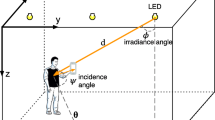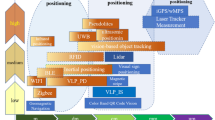Abstract
This paper describes a novel light sensor-based information transmission system for indoor positioning and navigation with particular benefits for mobile and wearable computers. It can seamlessly extend outdoor GPS tracking to the indoor environment. In a novel manner, fluorescent light is used as the medium to transmit information, which is encoded by using a pulse-frequency modulation technique. The user receives the encoded light information through a photo-receiver. The information is passed into the wearable or mobile computer after the data is decoded. This information allows positioning information to be given to indoor mobile and wearable computers. We design an economical transmitter circuit by adding few components to a commercial electronic ballast circuit for fluorescent lamps with price of less than US $10. The propose system can be used in indoor guidance and navigation applications. Exemplary applications are included in the paper, with experimented results detailed.






















Similar content being viewed by others
References
Ertan S, Lee C, Wollets A, Tan H, Pentland A (1998) A wearable haptic navigation guidance system. Second international symposium on wearable computers, Pittsburgh, pp 164–165
Moore T (1994) An introduction to the global positioning system and its applications. Developments in the use of global positioning systems, Institute of Engineering Surveying and Space Geodesy, pp 1–6
Thomas B, Demczuk V, Piekarski W, Hepworth D, Gunther B (1998) A wearable computers system with augmented reality to support terrestrial navigation. Second international symposium on wearable computers, Pittsburgh, pp 168–171
Thomas B, Close B, Donoghue J, Squires J, Bondi PD, Piekarski W (2002) First person indoor/outdoor augmented reality application: ARQuake. Pers Ubiquitous Comput 6:75–86
Feiner S, MacIntyre B, Hollerer T, Wester A (1997) A touring machine: prototyping 3D mobile augmented reality systems for exploring the urban environment. In: Proceedings of the first international symposium on wearable computers. Pers Ubiquitous Comput 1(4):78–81
Caudell T, Mizell D (1992) Augmented reality: an application of heads-up display technology to manual manufacturing processes. In: Proceedings of Hawaii international conference on systems science, Kauai, pp 659–669
Battlefied W, Caudell T (1999) Fundamentals of wearable computers and augmented reality. Lawrence Erlbaum Associates, Mahwah
Golding AR, Lesh N (1999) Indoor navigation using a diverse set of cheap, wearable sensors. In: Proceedings of the third international symposium on wearable computers, San Francisco, pp 29–36
Elenbaas W (1971) Fluorescent lamps. Macmillan, New York
Senior JM (1992) Optical fiber communications, principles and practice. Prentice-Hall, Englewood Cliffs
Jackson DK, Buffaloe TT, Leeb SB (1998) Fiat Lux : a fluorescent lamp digital transceiver. IEEE Trans Ind Appl 34(3):625–630
Bjork S, Falk J, Hansson R, Ljungstrand P (2001) Pirates! using the physical world as a game board. In: Proceeding of interact, Tokyo, pp 1–8
Intersense Company http://www.isense.com/
Bederson BB, Audio augmented reality: a prototype automated tour guide. In: Proceedings of human factors in computing systems (CHI 95). ACM, New York, pp 210–211
Thomas B, Close B, Donoghue J, Squires J, De Bondi P, Piekarski W (2002) First person indoor/outdoor augmented reality application: ARQuake. Pers Ubiquitous Comput 6(1):75–86
Ekahau Company http://www.ekahau.com
Randell C, Muller H (2001) Low cost indoor positioning system. In: Abowd GD (ed) Ubicomp 2001: ubiquitous computing, Springer, New York, pp 42–48
Author information
Authors and Affiliations
Corresponding author
Rights and permissions
About this article
Cite this article
Cheok, A.D., Li, Y. Ubiquitous interaction with positioning and navigation using a novel light sensor-based information transmission system. Pers Ubiquit Comput 12, 445–458 (2008). https://doi.org/10.1007/s00779-007-0140-9
Received:
Accepted:
Published:
Issue Date:
DOI: https://doi.org/10.1007/s00779-007-0140-9




